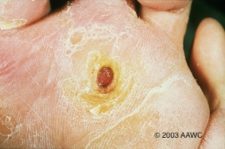Treatment of Diabetic Foot Ulcers
The potential consequences of a diabetic foot ulcer, including significant morbidity and a high risk of amputation, are so distressing that every effort should be made to prevent the development of the condition. However, this is by no means always possible, and up to 50% of patients with diabetes will be affected by diabetic peripheral neuropathy,1commonly leading to ulceration. Indeed, the lifetime risk of a person with diabetes developing foot ulceration is reported to be as high as 25%, despite attempts to introduce preventative measures.2
Once a diabetic foot ulcer has formed, treatment should be initiated immediately to limit the potential damage.2-4 Systemic measures should be introduced as a matter of priority, including aggressive treatment of dyslipidemia and hypertension, cardiovascular risk management and cessation of smoking.2 Surgical techniques including angioplasty or open bypass surgery can be effective in suitable patients, although amputation may ultimately prove to be the most appropriate option in some cases.2 Counter-intuitively, where the decision to amputate is made relatively early, outcomes may actually be improved compared with a late decision.
The wound bed should be managed according to the principles of wound bed preparation, although the optimal type of dressing for diabetic foot ulcers remains unclear due to a lack of trial data. Some evidence suggests that the use of vacuum-assisted closure (VAC) can help achieve positive outcomes in diabetic foot ulcers.
Management of an infected ulcer involves cleansing the wound, debriding any necrotic material, and probing with a sterile instrument to identify foreign bodies or expose bone.2 There is little evidence from randomized trials to direct the use of antibiotic therapy, and use of antibiotics therefore tends to be empirical and based on previous experience. Management of underlying osteomyelitis is also important.
To learn more about diabetic foot ulcers, including preventative measures and best current treatment strategies, please visitwww.woundeducators.com. There you will find information on our comprehensive range of wound management courses to suit healthcare professionals across the full spectrum of qualifications and experience.
References
- Tesfaye S, Selvarajah D. Advances in the epidemiology, pathogenesis and management of diabetic peripheral neuropathy. Diabetes Metab Res Rev 2012; 28(Suppl 1): 8-14.
- Khanolkar MP, Bain SC, Stephens JW. The diabetic foot. Q J Med 2008; 101: 685-695.
- Baranoski S, Ayello EA. Wound Care Essentials. Practice Principles. 2nd Edition. Lippincott, Williams & Wilkins, PA 2008
- Dorresteijn JAN, Valk GD. Patient education for preventing diabetic foot ulceration. Diabetes Metab Res Rev 2012; 28 (Suppl 1): 101-106


Hi Adnan, I recommend that you look at our wound care certificationn courses and choose the course that best meets your educational background. If you have any questions please contact us.